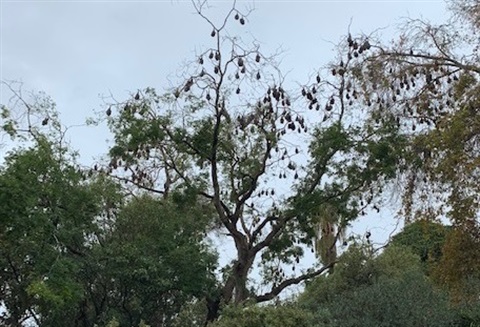Grey Headed Flying Fox

The Grey-headed Flying-fox is a threatened species in Victoria.
Known for their fly-outs at sunset, you may find flying foxes visiting your backyard, orchards and nearby parks to feed.
The grey-headed flying fox is easily recognisable by its reddish-coloured collar and grey head.
Flying-foxes are intelligent mammals, with excellent night vision and an acute sense of smell that helps them find nectar and navigate their way along the Australian coastline. Their legs have small muscles, which make them light enough to fly, but this means they are not strong enough to stand upright. Social and at times very noisy, flying-foxes have over 30 distinct calls they use to defend their territory, find their young and attract mating partners.
Grey-headed flying fox colony numbers fluctuate with the season – there are usually more numbers in summer than winter.
The Department of Environment, Land, Water and Planning offer the following tips for living with flying-foxes:
- If you choose to net your fruit trees to protect them from birds and flying-foxes, please use wildlife-safe netting. Flying-foxes and other animals are easily entangled in netting with holes larger than 5mm x 5mm and it is the leading cause of death and injuries for flying-foxes in urban areas. See the DELWP Fruit tree netting and wildlife fact sheets for more information.
- Flying-foxes can also get caught on barbed wire. If you have fences including barbed wire on your property, consider painting it a light colour or taping on plastic bags to make it more visible.
- Please do not approach flying-foxes or attempt to touch them yourself. A small percentage of flying-foxes carry Australian Bat Lyssavirus, which is similar to rabies. If you are concerned about the welfare of flying-foxes in your area, contact a local wildlife carer who is trained to handle bats.
- If you find a lifeless flying-fox, do not touch it. Please contact a local wildlife rescue organisation for assistance.
- If you are bitten or scratched by a flying-fox, thoroughly wash the wound, apply an antiseptic solution and see your doctor immediately.
- Even though no flying-fox to dog or cat transmission of disease has been recorded, dogs and cats should be kept away from flying-fox roost sites where possible.
For more information visit the DELWP website.